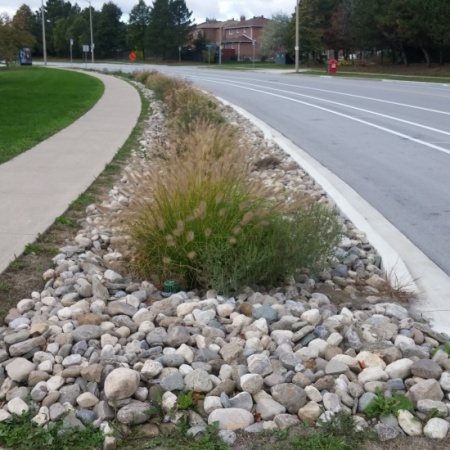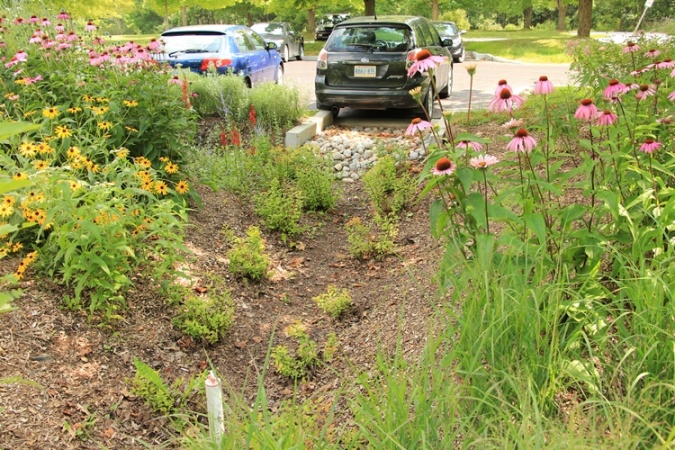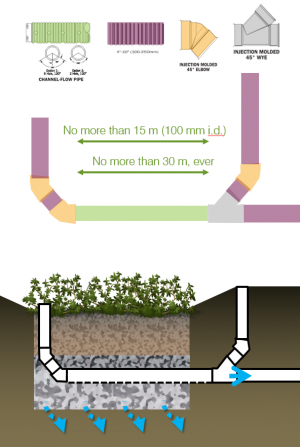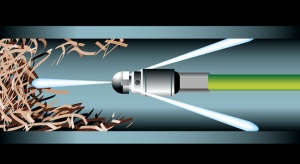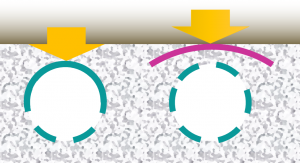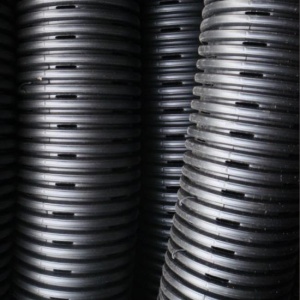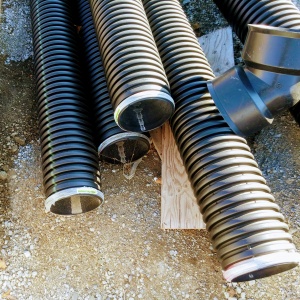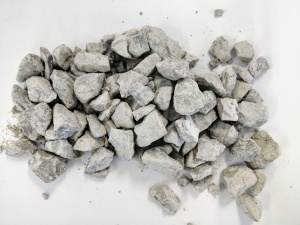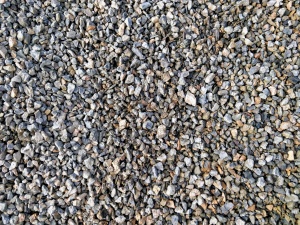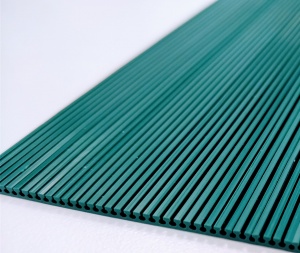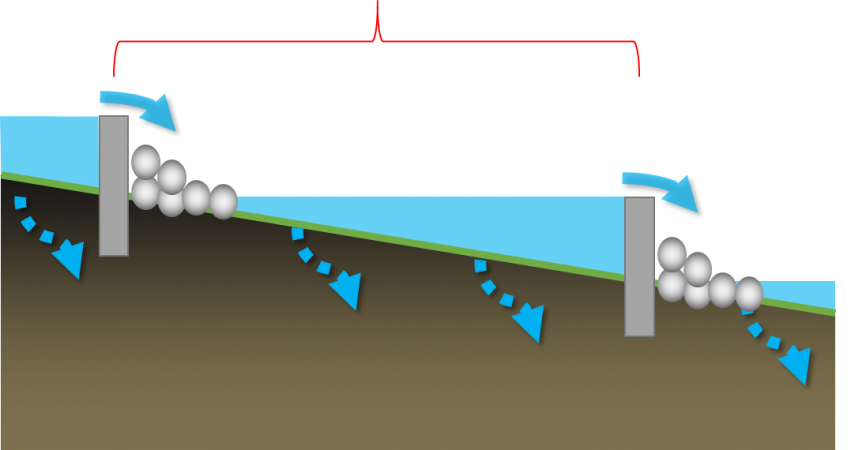Difference between revisions of "Swales"
Jenny Hill (talk | contribs) |
Jenny Hill (talk | contribs) |
||
| Line 12: | Line 12: | ||
*Connecting with one or more other types of LID}} | *Connecting with one or more other types of LID}} | ||
<table class = "table-responsive" "table table-striped"> | <table class = "table-responsive" table class = "table table-striped"> | ||
<caption><strong>Types of Swales</strong></caption> | <caption><strong>Types of Swales</strong></caption> | ||
<tr class ='success'><th>Property</th><th>Bioswale</th><th>Enhanced Grass Swale</th></tr> | <tr class ='success'><th>Property</th><th>Bioswale</th><th>Enhanced Grass Swale</th></tr> | ||
Revision as of 16:25, 10 July 2017
This article is about installations designed to capture and convey surface runoff along a vegetated channel.
Overview[edit]
Swales are linear landscape features consisting of a drainage channel with gently sloping sides. Underground they may be filled with engineered soil and/or contain a water storage layer of coarse gravel material. Two variations on a basic swale are recommended as low impact development strategies, although using a combination design of both may increase the benefits:
Bioswales are sometimes referred to as 'dry swales', 'vegetated swales', 'water quality swales' or 'inline bioretention'. This type of structure is similar to a bioretention cell but with a long linear shape (surface area typically >2:1 length:width )
Enhanced Grass Swales are a lower maintenance alternative, but generally have lower stormwater management potential. The enhancement over a basic grass swale is in the addition of check dams to slow surface water flow and create small temporary pools of water which can infiltrate the underlying soil.
Swales are an ideal technology for:
- Sites with long linear landscaped areas, such as parking lots
- Connecting with one or more other types of LID
| Property | Bioswale | Enhanced Grass Swale |
|---|---|---|
| Surface water | Minimal Any surface flow can be slowed with check dams | Ponding is encouraged with check dams |
| Engineered soil | Biomedia required | Amendment preferable when possible |
| Underdrain | Common | Uncommon |
| Maintenance | Medium to high | Low |
| Stormwater benefit | High | Medium |
| Biodiversity benefit | Increased with native planting | Lower |
The fundamental components of a swale are:
- Graded channel
- Planting
Additional components may include:
- Biomedia - an engineered soil mix
- Underdrain with clean out and inspection ports
- Impermeable membrane to prevent infiltration to soils below
- Check dams
Planning Considerations[edit]
Planning Content
Design[edit]
Pre-treatment and inlets
For more detail see article on Pre-treatment and inlets
To minimize erosion and maximize the functionality of the swale, sheet flow of surface water should be directed into the side of the BMP. Vegetated filter strips and shallow side slopes are ideal. Alternatively, a series of curb inlets can be employed, where each has some form of flow spreading incorporated. Single point inflow can cause increased erosion and sedimentation which will damage vegetation and contribute to BMP failure. Again, flow spreading devices can mitigate these processes, where concentrated point inflow is required.
Underdrains
Underdrains comprise a length of perforated pipe embedded into a layer of reservoir aggregate. They are an optional component of bioretention systems, stormwater planters, swales and soil cells used to support urban trees. Their design varies according to the drainage requirements of the installation, and the available maintenance access.
Underdrains for infiltrating practices[edit]
The perforated pipe within the drain should be elevated from the base to promote infiltration of the water stored beneath. The depth of this internal water storage reservoir should be sized to capture and infiltrate the design storm event runoff volume based on the desired drainage time and the design infiltration rate of the native soils below. An alternative design configuration is to install the perforated pipe on the base of the practice and using an upturned outflow pipe to permit the required head of water to be stored.
- Underdrain access structures, which may be maintenance holes or vertical standpipes connected to the perforated pipe, must be included in the design for periodic inspection and flushing of the perforated pipe. Negotiating 90 degree bends will be troublesome for most push camera and jet nozzle cleaning equipment, so it is preferable that 45 degree pipe couplings be used instead.
| Pipe internal diameter (mm) | Maximum distance between cleanouts (m) |
|---|---|
| 100 | 15 |
| 200 or greater | 30 |
In some cases where the underdrain layer has sufficient depth to accommodate it, a larger diameter perforated pipe (e.g. ≥ 300 mm) may be used to add further storage capacity to a bioretention or a bioswale project. Ultimately this idea may result in the use of infiltration chambers or other void-forming structures to create significant reservoir storage beneath a bioretention filter media bed. Be sure to check with manufacturers about the compatibility of their systems with trees.
Underdrains for non-infiltrating practices[edit]
Below ground[edit]
Where a stormwater planter or biofiltration cell is contained within a concrete box or completely lined to prevent infiltration, the perforated pipe should be bedded on a thin layer of fine aggregate. This thin layer is to hold the pipe in place during construction, and to permit free ingress of accumulated water through holes on the underside of the pipe. As storage in a non-infiltrating practice is predominantly through soil/water tension, the depth of reservoir should be minimised to just accommodate the pipe. A pair of vertical clean out pipes/wells should be included in the design, for inspection and periodic flushing of accumulated sediment. As most hydro-jetting apparatus used for this has some trouble accommodating narrow 90 deg bends, it is important that both ends of a perforated pipe be connected with a pair of 45 deg elbows/Y connectors instead.
Above ground[edit]
Where possible the underdrain pipe should be designed without any bends for easy inspection and maintenance. Otherwise see advice above regarding connectors.
- To optimize water distribution and promote infiltration the base of the storage reservoir and the underdrain pipe should be graded level.
- Where drainage or conveyance to a downstream facility is a greater priority, the base of the reservoir and the underdrain pipe may have a gradient of up to 1-2%.
Maintenance and inspection[edit]
- To permit access by cameras or cleaning apparatus, 90 degree connectors must not be used in subterranean underdrains. Instead 2 x 45 degree connectors, or preferably 3 x 30 degree connectors should be used (see figure to the right).
- For the same reason, dual walled perforated pipes with smooth internal walls are highly recommended to reduce the potential snagging of maintenance equipment.
- The recommended distances between clean outs is based on advice for filter beds in the Ontario Building Code[2]. However, the access capabilities of difference apparatus and contractors varies and designers are advised to take advice from maintenance operators in this matter.
Material specifications[edit]
Pipes[edit]
Perforated pipes are a common component of underdrains used in bioretention, permeable pavements, infiltration trenches and exfiltration systems.
Pipes should be manufactured in conformity with the latest standards by the Canadian Standards Association (CSA) or ASTM International.
- Perforated pipes should be continuously perforated, smooth interior HDPE or PVC.
- Wherever possible pipes should be ≥200 mm internal diameter to reduce potential of freezing and to facilitate push camera inspections and cleaning with jet nozzle equipment.
- Smooth interior facilitates inspection and maintenance activities; internal corrugations can cause cameras or hydrojetting apparatus to become snagged.
- A perforated pipe with many rectangular slots has better drainage characteristics than a pipe with similar open area provided by fewer circular holes [3].
- Non-perforated pipes should be used for conveyance of stormwater to and from the facility, including overflow. It is good practice to extend the solid pipe approximately 300 mm within the reservoir or practice to reduce the potential for native soil migration into the pipe.
See also: Flow through perforated pipe
Reservoir gravel[edit]
This article gives recommendations for aggregate to be used to store water for infiltration. This is usually called 'clear stone' at aggregate yards.
To see an analysis of Ontario Standard Specifications for granular materials, see OPSS aggregates.
For advice on decorative surface aggregates see Stone
Gravel used for underdrains in bioretention, infiltration trenches and chambers, and exfiltration trenches should be 20 or 50 mm, uniformly-graded, clean (maximum wash loss of 0.5%), crushed angular stone that has a porosity of 0.4[4].
The clean wash to prevent rapid accumulation of fines from the aggregate particles in the base of the reservoir. The uniform grading and the angularity are important to maintain pore throats and clear voids between particles. (i.e. achieve the porosity). Porosity and permeability are directly influenced by the size, gradation and angularity of the particles [5]. See jar test for on-site verification testing protocols.
Gravel with structural requirements should also meet the following criteria:
- Minimum durability index of 35
- Maximum abrasion of 10% for 100 revolutions and maximum of 50% for 500 revolutions
Standard specifications for the gradation of aggregates are maintained by ASTM D2940
The highest porosity is found in uniformly graded aggregate, as there are no smaller particles to occupy the inter-particle pores. [5]
Higher permeability is found in larger, angular, uniformly graded aggregate. This is due to larger pore sizes and lower tortuosity. [5]
Choker layer[edit]
In bioretention systems a choker layer of ≥ 100 mm depth is the recommended method to prevent migration of finer filter media into the underlying storage reservoir aggregate. These same mid-sized granular materials are recommended for use in Stormwater planter underdrains and may be useful in the fine grading of foundations courses for permeable pavements.
Suitable materials include:
- High performance bedding (HPB)
- Clean, angular aggregate screened to between 6 and 10 mm. Widely available and designed specifically for drainage applications. Free from fines by definition.
- HL 6
- Is a clean, angular aggregate screened between 10 and 20 mm. Free from fines by definition.
- Pea Gravel
- Rounded natural aggregate, screened between 5 and 15 mm, and washed free from fines.
In most scenarios, a geotextile layer is unnecessary and has been associated with rapid decline and clogging in some circumstances. Geotextiles may be used to separate the underdrain from native soils on the vertical faces.
Alternative technology[edit]
Smart Drain is a polymer ribbon-like material with capillary drains on the underside; it's use has recently been demonstrated in bioretention[6]. It's low profile may make it particularly well suited to non-infiltrating practices, such as Stormwater planters.
Check dams
Check dams are a feature of enhanced swales. They promote infiltration and evaporation by promoting limited ponding. To design check dams into a swale:
- The height of each dam is determined by the depth of ponded water that will infiltrate in 24 hours. The infiltration may be into the native soils, into biomedia, or some other soil amendment may be proposed in the design.
- Dams are usually installed between 10-20 m along the swale. They are distributed such that the crest of each dam is at approximately the same elevation as the toe of the upstream dam. If the slope along the swale varies, so should the distance between the dams.
- Dams may be constructed of any resilient and waterproof material, including: rock gabions, earth berms, coarse aggregate or rip-rap, concrete, metal or wood.
- Energy dissipation and erosion control measures should be installed in the 1 - 2 m downstream of each dam. Examples include large aggregate or turf reinforcement.
<panelSuccess>
</panelSuccess>
Performance[edit]
Performance Content
Incentives and Credits[edit]
In Ontario
City of Mississauga
The City of Mississauga has a stormwater management credit program which includes RWH as one of their recommended site strategies[1].
LEED BD + C v. 4
SITES v.2
See Also[edit]
External Links[edit]
| SEND US YOUR QUESTIONS & FEEDBACK ABOUT THIS PAGE |
- ↑ Province of Ontario. (2018). O. Reg. 332/12: BUILDING CODE. Retrieved February 23, 2018, from https://www.ontario.ca/laws/regulation/120332
- ↑ Province of Ontario. (2018). O. Reg. 332/12: BUILDING CODE. Retrieved February 23, 2018, from https://www.ontario.ca/laws/regulation/120332
- ↑ Hazenberg, G., and U. S. Panu (1991), Theoretical analysis of flow rate into perforated drain tubes, Water Resour. Res., 27(7), 1411–1418, doi:10.1029/91WR00779.
- ↑ Porosity of Structural Backfill, Tech Sheet #1, Stormtech, Nov 2012, http://www.stormtech.com/download_files/pdf/techsheet1.pdf accessed 16 October 2017
- ↑ 5.0 5.1 5.2 Judge, Aaron, "Measurement of the Hydraulic Conductivity of Gravels Using a Laboratory Permeameter and Silty Sands Using Field Testing with Observation Wells" (2013). Dissertations. 746. http://scholarworks.umass.edu/open_access_dissertations/746
- ↑ Redahegn Sileshi; Robert Pitt, P.E., M.ASCE; and Shirley Clark, P.E., M.ASCE Performance Evaluation of an Alternative Underdrain Material for Stormwater Biofiltration Systems, Journal of Sustainable Water in the Built Environment, 4(2), May 2018 https://doi.org/10.1061/JSWBAY.0000845
